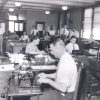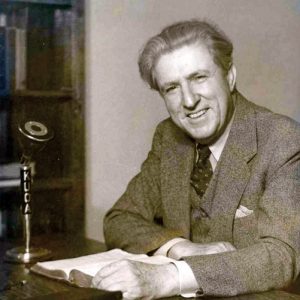calsfoundation@cals.org
KUOA
Radio station KUOA started at the University of Arkansas (UA) in Fayetteville (Washington County) and later belonged to John Brown University (JBU) in Siloam Springs (Benton County). These schools used the station to broadcast programs such as educational talks, religious programs, music, local information, and sports. In the twenty-first century, KUOA is an all-sports station nicknamed “Hog Sportsradio.” It is generally considered to be the oldest radio station in Arkansas that is still broadcasting.
According to Ray Poindexter in his book Arkansas Airwaves, the UA Department of Engineering began experiments with a wireless telegraph in 1897 and had a wireless station in 1916 licensed with the call letters 5YM. A license for the school’s first commercial AM radio station, KFMQ, was issued on December 4, 1923. This station first used KUOA as its call letters on February 15, 1926.
In 1931, as the Great Depression deepened, the UA Board of Trustees decided to lease out operation of the radio station to cut costs. In his Centennial History of the University of Arkansas, Robert A. Leflar opines that this transfer was “one of the University’s serious errors of foresight.” He continues, “It is easy to see, forty years later, the educational possibilities, both on and off campus, that were then too gladly gotten rid of.”
Lessees based in St. Louis, Missouri, and Fort Smith (Sebastian County) ran the station. Members of the Fulbright family then formed KUOA, Incorporated, to purchase the station, and on April 1, 1933, they took control, with Roberta Waugh Fulbright as president, John Clark as secretary-treasurer, and daughters Roberta Fulbright as station manager and Helen Fulbright as vice president.
John Elward Brown negotiated with the Fulbrights to buy KUOA and began broadcasts from the Fayetteville studio on June 1, 1935. He chose a recent JBU graduate, Storm Hammond Whaley, as station manager. It was not until November 26, 1936, that the KUOA studio, transmitter, and tower were all on the JBU campus. Brown had already had some experience with radio and felt strongly that radio had great potential to help him broadcast evangelical and educational programs to a wide audience.
KUOA added an FM outlet in 1947. In 1982, the KUOA-FM call sign was changed to KLRC, which still broadcasts from the campus of JBU and still offers training opportunities for JBU students.
JBU sold KUOA-AM to Dewey Johnson in 2005, but health problems forced Johnson to retire from broadcasting later that year, with ownership being transferred to Galen Gilbert. The station continued the country music and local information format Johnson had developed until it was sold again to Gary Bunyard in 2008. KUOA became an all-sports station with studios in Springdale (Washington County), though the main transmission tower is still located on the JBU campus; it then became a Spanish-language station.
For additional information:
Kennedy, Ralph C., Jr., and Thomas Rothrock. John Brown of Arkansas: 1879–1957. Siloam Springs, AR: John Brown University, 1999.
KLRC. http://www.klrc.com (accessed February 7, 2022).
Leflar, Robert Allen. The First 100 Years: Centennial History of the University of Arkansas. Fayetteville: University of Arkansas Press, 1972.
Poindexter, Ray. Arkansas Airwaves. North Little Rock, AR: 1974.
Don Warden
Siloam Springs Museum



 John Elward Brown
John Elward Brown 



It is significant that Loy E. Barton first proposed the use of ” Class B high level plate modulation” in his 1925 master’s thesis at UA in Fayetteville. He returned to re-work the KUOA transmitter in 1928 with his special audio transformer, which was the first of its kind in the world. He was soon hired by RCA and a patent was applied for in 1932 which was granted in 1936. U.S. pat # 2,063,290. This method was used throughout the world for virtually all AM radio stations for the next sixty years.
A couple of other significant facts surrounding this invention were that this method was used to its legal limit with the building of Powell Crosley’s Radio station WLW in Cincinnati, Ohio. Upon its completion in 1934, it was the world’s most powerful radio transmitter with an output of half a million watts. It was the only one of its kind ever built. Most U.S. “clear channel” AM broadcast stations have a power limit of 50,000 watts. This invention was also used in millions of home radio sets. Barton continued to work for RCA and his name is also on US patent # 2594380A Synchronizing apparatus for color signal sampling oscillators, dated 1950. “Color burst,” as it is commonly referred to, made color TV possible. No small feat. A Google search shows 49 patents issued to him between 1932 and 1965. I’m sure there are more.
(2012) The call sign was changed to KMCK in ’76 (?). I think it was the late ’70s or possibly 1980 that KMCK was sold (I don’t know who bought it). KLRC signed on a few years later. KLRC was a totally separate facility and was not KMCK with a new call sign. KLRC is owned and operated by John Brown University. I used to be in broadcasting, many years ago, and I am familiar with the Northwest Arkansas radio scene.